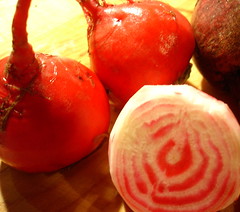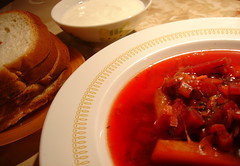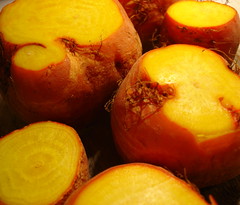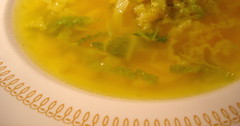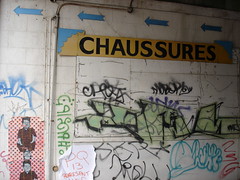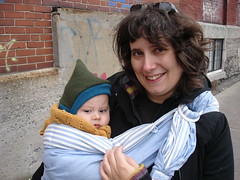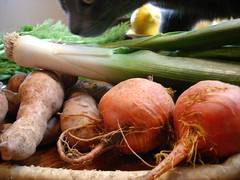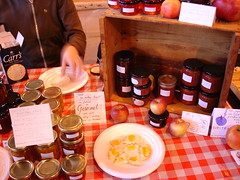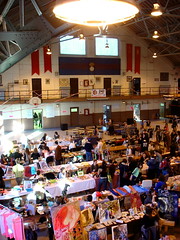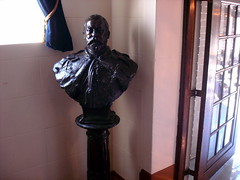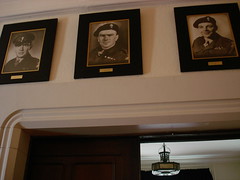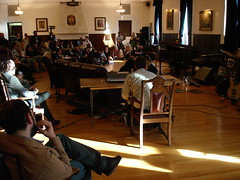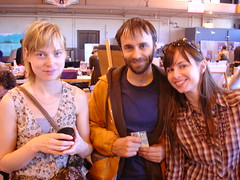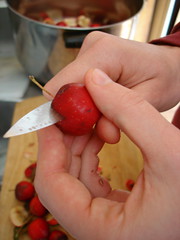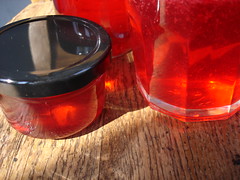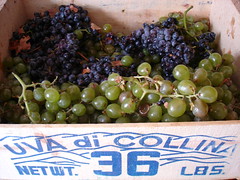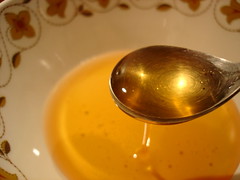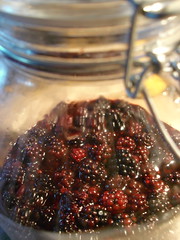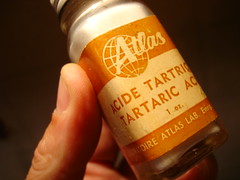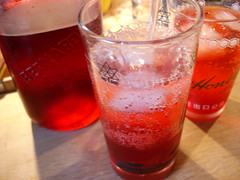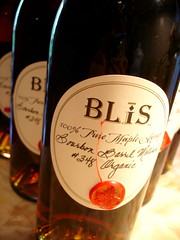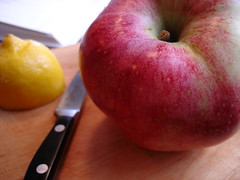Return to Covey Hill, rev. ed.
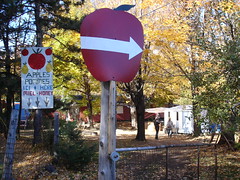 fig. a: Mr. Safian's stand, Rte. 202
fig. a: Mr. Safian's stand, Rte. 202
For some reason we were slow to return to Covey Hill even though we’d had such a great experience there last year. Weather? Puces Pop? We were never sure why exactly, but it most certainly had something to do with the endless summer of 2005, when a warm summer stretched into a lengthy Indian summer. By the time we were done we’d been out to collect apples (and on some occasions pears) three times, the last time in early November. As some of you may remember, we discovered the man we now call our apple guy on our very first trip out last year—a trip prompted by an almost Wellesian search for the origins of an apple crate.* Yes, that was the trip where we explored Covey Hill for the first time. It was also the trip where we met Mr. Eugene Safian.
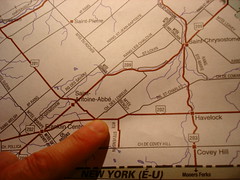 fig. b: approximate location of Mr. Safian's stand
fig. b: approximate location of Mr. Safian's stand
Of course, last year we took to calling him Monsieur Safian because we were absolutely convinced he was a b’en bon Québecois--so much so that we’d spoken to him exclusively in French in all our dealings with him. This year we found out that although he does speak French with a perfect rural Quebecois accent, he also speaks English perfectly fluently (again, with a rural accent) and that he identifies himself primarily as an “Anglo” even though his mother tongue was yet another language.
We’d had suspicions that M. Safian had Eastern European blood from the start—there was something about that family name that struck us as not exactly pure laine and maybe Hungarian or Romanian or something. When he quizzed us, those were our first two guesses, and when both of those came up short we guessed Armenian. He told us, “Yeah, everyone thinks it’s Armenian.” In fact, his parents came from the Ukraine, as it turns out, and young Eugene grew up speaking Ukrainian at home. His father had moved to Canada sometime in the 1920s, and like many other immigrants at that time (my grandfather being one of them), he bounced around the country in search of work, even making it as far as British Columbia before eventually returning east and settling in southwestern Quebec, where he established himself as an orchardist and started a family. It was Eugene’s mother who changed the family name to Safian in an attempt to create something that would seem more familiar to outsiders. The name has been mistaken for Armenian ever since.
Anyway, maybe it was all due to that shared Eastern European heritage or something, but we clicked with Mr. Safian from the first time we met him—we definitely had some kind of connection. Usually these things manifest themselves in a knowing look, a twinkle in the eye, a hesitant question about family background--like when The Capitan/Le Capitaine, the venerable Jean-Talon egg merchant, gave Michelle one of those looks one time and then asked, "Are you Czech?", completely out of the blue (we've been loyal ever since). With Mr. Safian it was different. The last time we went to visit him last year, that Monday morning in early November, we showed up and his stand was disassembled, his parking lot was cordoned off.
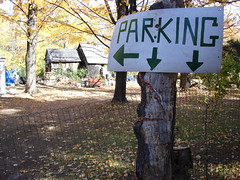 fig. c: parking lot, Mr. Safian's
fig. c: parking lot, Mr. Safian's
We parked the car along the side of Rte. 202 and took a look around. No sign of Mr. Safian, no sign of Susie, his faithful Doberman mix. Michelle wandered down along the 202 to the end of the slip of an orchard that makes up Mr. Safian’s southern plot. I wandered in the other direction and knocked at his front door. No luck. A few minutes later we regrouped and tried to figure out what to do. We’d just decided that we would head towards Franklin centre and hit another apple stand or two, before coming back to see if we’d have better luck the second time around, when who should appear miraculously out of the dense forest on the south side of the road but Mr. Safian himself. Sure enough he opened up his operation for us, and a half an hour later we were on our way again with a trunkload of late autumn apples.
This year we had a similar experience. We’d just been telling our friends K and S about the charms of Mr. Safian and the stroke of good luck we’d had with him the year before. Once again, it was a Monday morning. Once again, we pulled up and his stand was closed up, the parking lot was roped off, and there was no sign of Mr. Safian. Once again, we fanned out to see if we could spot him. Once again, we came up empty. We were in the process of trying to figure out what our next step would be, especially seeing as none of the apple trees we’d seen along the way were showing apples, when, once again, Mr. Safian appeared out of the blue, this time in a car. It seemed like happy days were here again, but the first thing he told us was that not only were his trees clean, but he was completely out of apples. It had been an early season this year and the trees hadn’t produced quite as many as they had in other years. We said, “Completely?," and he said, “Well, I may have a few apples left—some Macs, some Cortlands—but don’t get your hopes up.” He opened up his shed, and—he was right—there wasn’t much left, but there was plenty enough for the likes of us, and much more than he’d been letting on. Not only did he still have Russets and Spys, two of our absolute favorites, but we had lots of Macs left and some very impressive-looking (and tasting) Cortlands. We didn’t get to pick them this year, but otherwise we couldn’t have been happier.
We ended up going to see Mr. Safian twice in the course of one week, the second time to pick up a 66-lb crate of phenomenal Flemish Beauty pears, and on this second trip he filled us in on some of the vagaries of the apple trade. Yes, it had been a short growing season this year, and, yes, apple trees in southwestern Quebec hadn’t produced nearly as many apples as they were capable of producing, but there were other factors at play that had led to the present apple shortage. You see, Mr. Safian explained to us, upper upstate New York has a couple of growing regions that produce apples, and especially Macs, on a massive scale that absolutely dwarfs the output of an area like the Franklin-Covey Hill-Hemmingford corridor. These operations are “huge,” he told us, “huge.” One of the biggest of these apple orchard regions is the one that surrounds the town of Chazy, right alongside Lake Champlain some 15 miles or so south of the Canadian border. One orchard alone measures about 25 square miles of territory and produces an astronomical number of apples per annum, he claimed. Well, it seems that Chazy suffered a devastating hailstorm this summer, one that wiped out the majority of the town’s apple crop in one fell swoop. Usually, hailstorms are pretty localized and they might take out a strip of agricultural land. This one had been different: it ravaged a much larger area, including most if not all of that massive mega-orchard Mr. Safian had described to us. Just how big a hailstorm are we talking about? One eyewitness reported five to ten minutes of sustained 3/4” hail, enough to cover the ground with a thick layer. This had the effect of throwing the balance in the Northeastern apple market completely out of whack. And it meant that the demand for Quebec apples from south of the border was enormous.
There was yet another factor affecting Mr. Safian’s supply, though. He’d picked up a new client last year when a fellow apple grower/friend of his decided to get out of the orchard business after some tough seasons, handing over a prized client in the process. And just who/what was this new client? Not some big apple juice or apple sauce conglomerate, not some big bakery, not some local cidrerie. No, it was a nunnery situated in the whimsically named Salaberry-de-Valleyfield nearby, a town otherwise famous for its hydroelectric projects and its notorious traffic cops (you’ve been warned). Last year, the good sisters [he wouldn’t tell us which order] placed an order for an entire bin of apples—Cortlands only!—20 bushels to the bin.
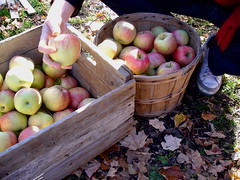 fig. d: "Cortlands, only Cortlands!"
fig. d: "Cortlands, only Cortlands!"
Apparently they’d been pleased with Mr. Safian’s Cortlands, because this year they doubled their order. Two weeks later they called again and asked if they could top up their order with another half a bin. By that time Mr. Safian was already running low, but he reluctantly said yes—what else could he do?—and somehow he managed to cobble together another 10 bushels of premium Cortlands. As he told us, “I’ve got no idea what those nuns do with all those apples, but when the nuns ask, you listen.” The deal had apparently been beneficial to both parties. The nuns had apparently been impressed with their bushels upon bushels; Mr. Safian had made out well. “Let’s just say I was smiling all the way to the bank,” as he put it, presumably because he’d sold so many apples in one go and managed to get a good price, but, then, you never know, he might very well had had something else in mind.
So there you have it. Last year, Quebec’s apple growers had a long growing season, one that allowed us to go a collect our last load of apples in early November, but the apples never really reached their full potential and a lack of early frost left them a bit fragile. This year there’d been a short growing season with low-production and unusually high demand, resulting in a serious shortage of apples, but three early frosts had made those apples that were available particularly sweet and unusually hardy. As the character of Roberto once put it in the film Down By Law, "It is a strange and beautiful world."
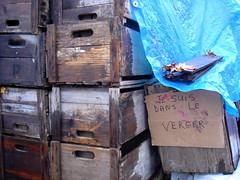 fig. e: "The orchardist is IN"
fig. e: "The orchardist is IN"
Oh, and Susie? We didn’t see her this year due to some rather serious health problems. Apparently she was still coming out occasionally to see people on weekends—she always had been a social dog—but mostly she’d been taking it easy, resting in the warmth and safety of home.
aj
*Okay, it really wasn’t "Wellesian" in the least, but the term has a nice ring to it.
